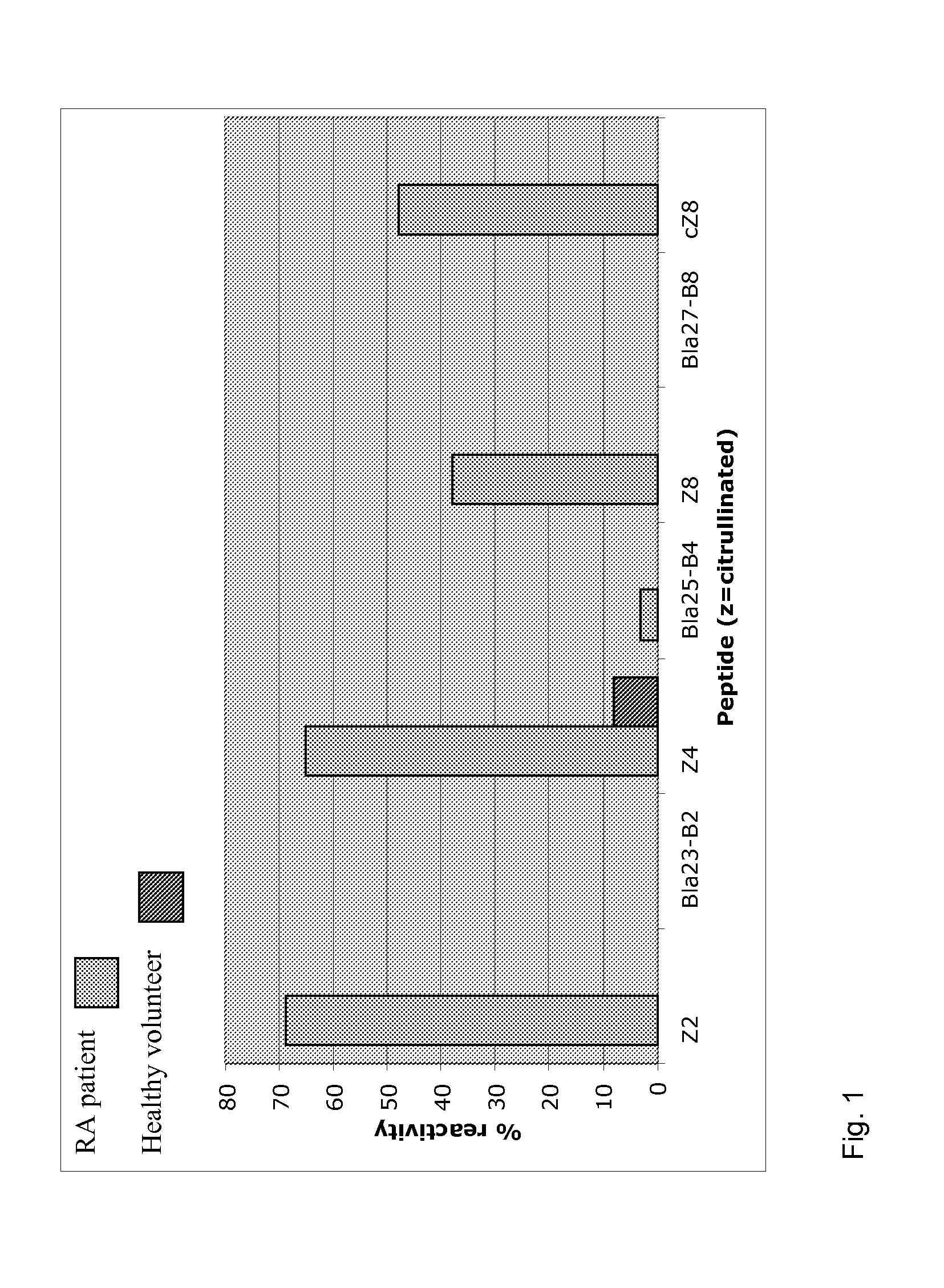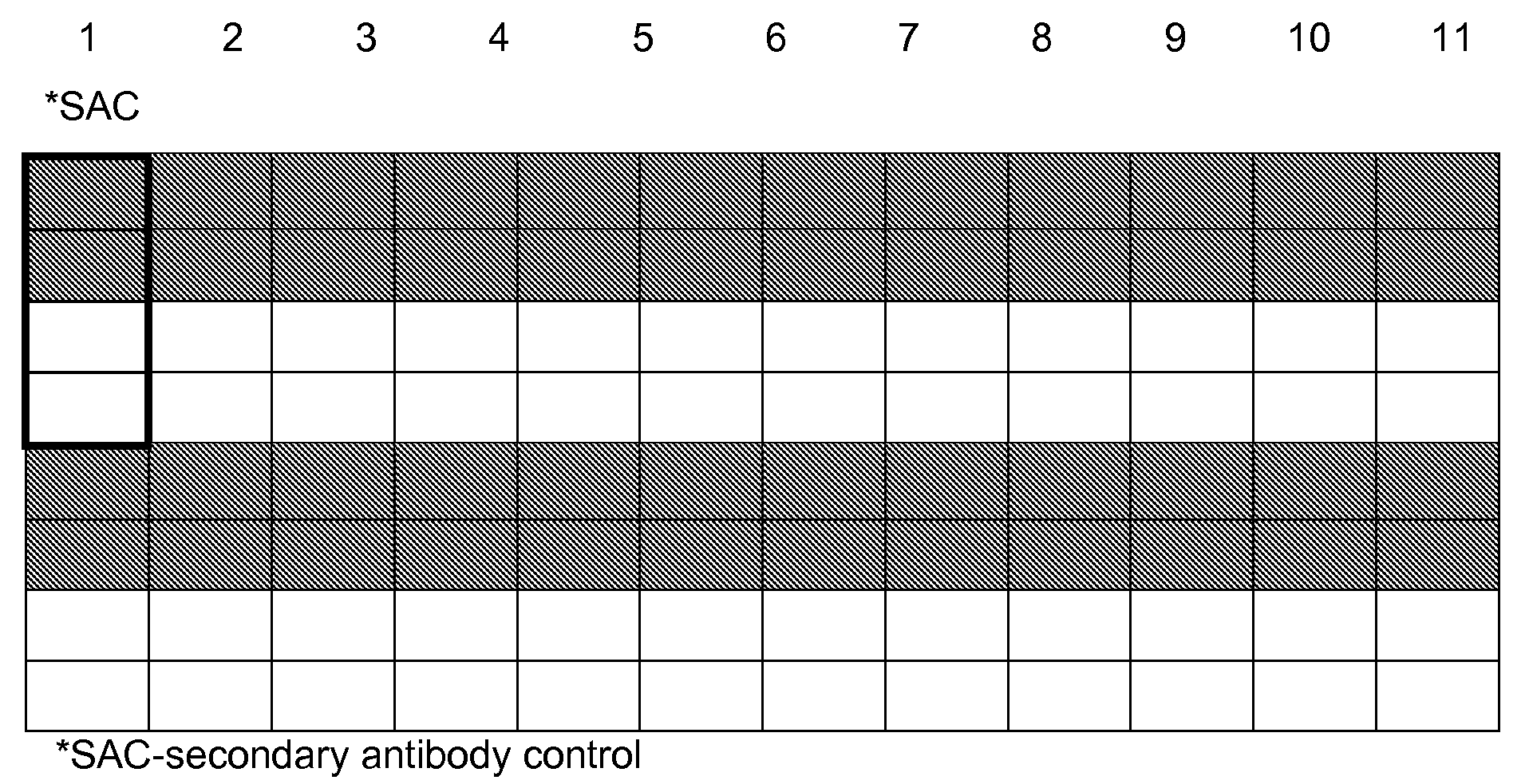HNRNP A3 Related Peptides and Use Thereof for Diagnosis of Rheumatoid Arthritis
- Summary
- Abstract
- Description
- Claims
- Application Information
AI Technical Summary
Benefits of technology
Problems solved by technology
Method used
Image
Examples
example 1
[0062]NeutrAvidin-Peptide-Antibody-ELISA
[0063]For the detection of antibodies against the peptides of the invention, a non-competitive single-site immunoassay was used with NeutrAvidin™-coated microtiter plates (Pierce, Rockford USA). The peptide was synthesized, biotinylated and lyophilized (Biotin-Ahx-HSXXXXXXXXXXXX(-CONH2). First, a stock of peptide was produced in distilled water (concentration: 1 mg / mL).
[0064]1 μL of this solution is enough for coating one well (corresponds approximately 500 pmoL peptide per well) in a total volume of 120 μL Protein-Free Blocking Buffer (Pierce, Rockford USA). The coated plates were shaken for 1 hour at room temperature (600 rpm) and incubated overnight at 4° C. The following work steps of the test procedure are listed in Table below (all steps at room temperature).
volumeincubation / work stepbuffer / materialper wellconditionswashPBS + 0.1% Tween20300 μLonce for 1 min,600 rpmblockPBS + 5% milk powder140 μL1 Stunde, 600 rpmwashPBS + 0.1% Tween20300...
example 2
[0068]Purpose of this experiment was to elucidate whether peptides of the invention can be used to diagnose specifically RA.
[0069]Sera (see table) from patients with RA, SLE, MCTD, systemic sclerosis, poly / dermatomyositis, primary Sjögren's syndrome, reactive arthritis, and osteoarthritis and healthy controls were investigated. The sera were taken from the local serum bank of and were derived from clinically and serologically well-defined patients. All RA patients fulfilled the 1987 revised criteria of the American College of Rheumatology, all SLE patients the 1982 criteria of the American College of Rheumatology, and all MCTD patients met the criteria of Alarcon-Segovia et al. For studies with early arthritis, 54 sera from patients were tested with a commercial CCP2 ELISA autoreactivity were selected. Anti-CCP antibodies were measured by (second generation) enzyme-linked immunosorbent assay (ELISA, Axis Shields Diagnostics) and considered positive at a cut-off value >5 arbitrary un...
example 3
[0073]The specific aims of this study were (i) to determine the frequency of Z1 (SEQ ID No. 14), Z2 (SEQ ID No. 3), Z3 (SEQ ID No. 15), Z4 (SEQ ID No. 5), Z8 (SEQ ID No. 7) in early arthritis and positivity in erosive arthritis among patients with very early RA; (ii) to compare the reactivity of Z1 (SEQ ID No. 14), Z2 (SEQ ID No. 3), Z3 (SEQ ID No. 15), Z4 (SEQ ID No. 5), Z8 (SEQ ID No. 7) and CCP2 of patients diagnosed with early RA who did progress to developing erosions to link radiological progression and serological variables, and thus to determine possible prognostic factors for development of erosive disease. Moreover synovial fluid from RA patients were tested.
[0074]ELISA tests were performed as described above.
[0075]As shown in Table 2, the peptides Z1 (SEQ ID No. 14), Z2 (SEQ ID No. 3), Z3 (SEQ ID No. 15), Z4 (SEQ ID No. 5), Z8 (SEQ ID No. 7) are able to detect early RA with a significant sensitivity and can identify early RA that was not detected by CCP2 ELISA.
TABLE 2Posi...
PUM
| Property | Measurement | Unit |
|---|---|---|
| Fraction | aaaaa | aaaaa |
| Fraction | aaaaa | aaaaa |
| Fraction | aaaaa | aaaaa |
Abstract
Description
Claims
Application Information
 Login to View More
Login to View More - R&D
- Intellectual Property
- Life Sciences
- Materials
- Tech Scout
- Unparalleled Data Quality
- Higher Quality Content
- 60% Fewer Hallucinations
Browse by: Latest US Patents, China's latest patents, Technical Efficacy Thesaurus, Application Domain, Technology Topic, Popular Technical Reports.
© 2025 PatSnap. All rights reserved.Legal|Privacy policy|Modern Slavery Act Transparency Statement|Sitemap|About US| Contact US: help@patsnap.com


